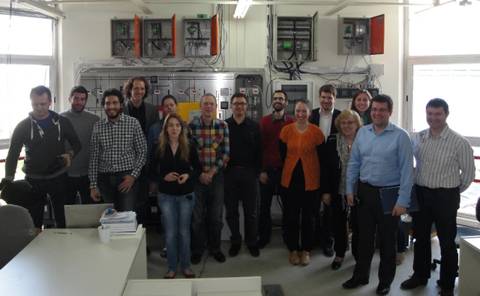JRA3-Hardware-in-the-Loop Workshop
20th of April 2012
A Technical Workshop on Hardware-in-the-Loop (HIL) simulation was held at ICCS-NTUA in the framework of DERri-JRA3. Advantages, applications and key issues of HIL and especially Power HIL simulation were presented. The performance of laboratory PHIL experiments on a hardware PV inverter showed the suitability of this approach for testing DER devices. The partners had the opportunity to discuss on technical issues and challenges and plan further collaboration on the HIL topic.
 |
JRA 3 - Real time simulation environment and parameter identification for power systems
The overall objective is to define a comprehensive hardware and software simulation environment for power systems, distributed generators, protection and control equipment which are going to play a major role in the change towards more active networks. Examinations with a powerful power
system simulation system including an interface to a hardware power system and components shall be applicable to more complex problem areas, and on the other hand the simulation results shall reveal more precise predictions for future applications.
The main focus of this JRA is to combine the expertise as well as the laboratory infrastructure available in the project consortium to establish a specialised test facility for hardware-in-the-loop simulation of power systems and components. The test facility will allow grid operators to gain comprehensive answers on system questions in regard to safety functions, grid management, security of supply and quality of supply. Plant supplier and operators profit from more precise component behaviour descriptions and better support of component developments.
New concepts for a dedicated test environment, which fulfils the needs of electricity industry and manufacturers as well as research institutes, will be developed and implemented. The available infrastructure of the project consortium will be effectively used.
This task mainly addresses following activities:
- Development and enhancement of simulation testing methods (concerning numerous testing objectives by software, hardware or both).
- Formulating requirements concerning simulation platform, types and characteristics of models used in research.
- Development of hardware-in-the-loop structures for continuous and sustained REAL-TIME simulation of power systems and components
- Modelling of Distribution Networks with Distributed Energy Resources using IEC standards.
- Unification of procedures and equipment used in simulation testing and research investigations.
- Coordination with publicly available results from other European projects.
The existing hardware infrastructure will be used to collect real performance data of DER and network equipment. If necessary additional tests and data recordings will be performed. Due to the many different types of DER available when jointly looking at the partner facilities a profound data basis for subsequent research activities (parameter identification, model making,...) is available.
Examples for possible analysis include the following
- closed-loop testing of physical devices (e.g. protection equipment and control equipment)
- analytical system studies
- transient network analysis in continuous, sustained real time
- effects of disturbances on power system equipment and networks.


